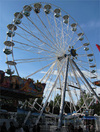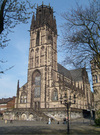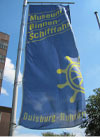Burgplatz and Town Hall - once royal court and imperial palace

The present Burgplatz forms Duisburg's the nucleus. The areal ideal for settlement is situated on a high-water free lower terrace. In the Middle Ages the place offered a view onto the nearby flowing Rhine and hustle and bustle at the market and harbour quarter. Until after the 2nd World War the castle character could be seen clearly in the development. Rows of houses marked the run of medieval fortification facilities.

Even the Romans visited this important strategically situated place to secure the Limes with the Ruhr estuary in advance. The springs of the 5th-century mention a Castrum Dispargum. The research connects this with a Frankish royal residence in the area of the Burgplatz. Later this Castrum had apparently the function of a royal Curtis, a farming estate as stopping point along the Hellweg. In 883/884 the Vikings ambushed the Oppidum Duisburh. The fortified village had then a remarkable economical importance.

In the security of a new fortification the place developed under the Ottonians to an imperial palace with representative stone buildings. 17 royal and imperial visits in Duisburg have been documented between 929 and 1129. Some royal buildings are well-know through excavations. In the area of the present town hall arose a representative building complex consisting of hall buildings and royal chapel. Along the surrounding fortification were probably residential and farm buildings and stables situated. In the church surrounding was a graveyard.
The new building of the town hall around 1900 and building demolition after the 2nd World War deeply changed the appearance.

 Deutsch
Deutsch Nederlands
Nederlands Dansk
Dansk Österreichisch
Österreichisch Po Polsku
Po Polsku


































